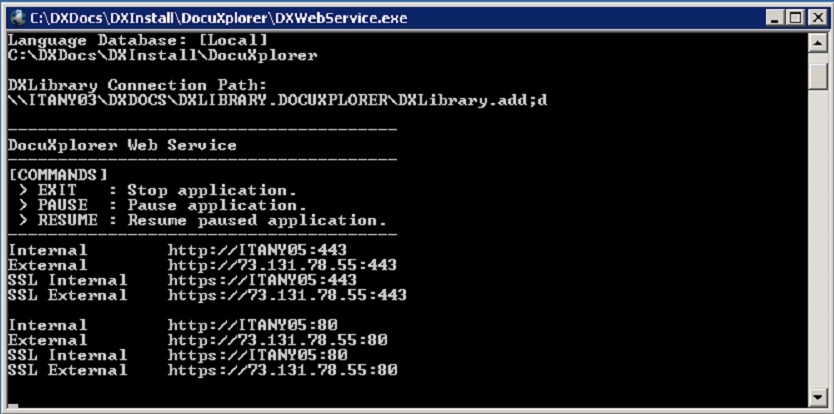
This Help topic refers to the following editions:
þ Enterprise þProfessional þ Small Business
System Requirements
Supported Browsers
The DocuXplorer Web Client supports industry standard internet browsers such as IE8 or higher, Mozilla, Chrome and Navigator. You must have Java Script enabled in order for the web interface to rendered in the browser.
Supported Operating Systems
The DocuXplorer Web Service will run on Windows 10 and above, Server 2008 R2 and above.
Installation
The DocuXplorer Web Service is automatically installed as part of Enterprise, Small Business and Professional versions of DocuXplorer. It is located in the same folder where your DocuXplorer.exe is located and is called DXWebService.exe. To close the DXWebService click on the X in the upper right corner. The DXWebService must be running in order for the DX Web Client to access the DXWebService.
Folder Security Settings
The DXWebService reads and write users session information to "C:\Program Files\DocuXplorer 202?\static\" for the Personal and Professional versions of DocuXplorer and "..\DXDocs\DXInstall\\DocuXplorer\static\" for the Small Business and Enterprise versions. Please make sure to assign read/write permission to this folder for the account that will be running the DXWebService.

Once the Web Service is started it will locate your ADS.INI, DXLibrary and internet port that is not in use by another application.
Description of Web Service display settings
Database Configuration:
The location the ADS.INI configuration file used by DocuXplorer to locate the database and other startup settings
DXLibrary Connection Path:
The path to the DXLibrary that is accessed via the Desktop and Web Clients.
Internal / External Ports:
These lines represent the URLs that can be used to access the DocuXplorer Web Client interface. To access the Web Client within your office enter the Internal web address. If the default port (80) is not free you will need to enter the port address when shown in the dialog e.g. HTTP:// My Computers Name:8080. The Web Service will automatically increment the number 8080 until it finds a port that is free.
SSL Internal/External:
Encryption is support via SSL to ensure that no other computer can access the information while using the Web Client. SSL, Short for Secure Sockets Layer, a protocol developed by Netscape for transmitting private documents via the Internet. SSL uses a cryptographic system that uses two keys to encrypt data − a public key known to everyone and a private or secret key known only to the recipient of the message. Both Netscape Navigator and Internet Explorer support SSL, and many Web sites use the protocol to obtain confidential user information, such as credit card numbers. By convention, URLs that require an SSL connection start with https: instead of http
ADS.INI flle configuration Settings:
The ads,ini file can be opened with notepade.exe or any other plain text editor and contains the following information.
[WebServer]
SSLpwd=docuxplorer
SSLcertFile=server.crt
SSLprivateKey=server.key
SSLcaFile=servert.pem
httpPort=80
httpsPort=443
UserTimeOut=1800
MaxUploadSize=5000000
[WebService]: Is the group that identifies the settings for the WebService and the default values that can be changed.
SSLpwd: Password used by SSL certificate
SSLcertFile: file name of SSL certificate file
SSLprivateKey: file name of private key file for SSL certificate
SSLcaFile: file name of certificate of authority
httpPort: 80 Is the default port address the WebService listens to when responding to Web Client requested for information. Adjust this value if the default port is already in use by another service. To disable http set the port to 0
httpsPort: Is the same as HTTP but HTTPS (default port 443) is a combination of the HTTP and SSL/TLS protocols, which provides encryption while authenticating the server. The main idea is to create a secure channel over an insecure network, ensuring "reasonable" protection from eavesdroppers and man-in-the-middle attacks. Adjust this value if the default port is already in use by another service. To disable https set the port to 0
UserTimeOut: Enter the number of second of inactivity before a user's session is disconnected. The default is 1800 (30 minute), the minimum value is 60 ( 1 minute).
MaxUploadSize: Enter the maximum number of byes for a file to be upload to the service. 5000000 or 5MB is the default.
Security Consideration:
We provide an unsigned SSL certificate for testing purposes only and should not be used for production systems. It is required that you purchase a SSL certificate for your domain to insure proper security for your the DX Web Service. http://www.sslshopper.com/ provides background information on the different types of certificates and suggested vendors.
Enable login security in DocuXplorer so people outside your office can not access unauthorized information. See Security for more information on this topic.
To disable http or https, set the port to an address that can be access from the internet via your router.
Password Reminder Support:
To enable users to retrieve forgotten passwords, open the DocuXplorer Desktop on the server and select Tools | Options | Manage Users and Group and enter the users email address. Also select Tools | Options | Workstation | Email Settings and select the email client support that should be used when sending a user password reminder information.
Running DXWebService.exe as Microsoft Service
There are two ways to run the DXWebServer.exe as a Service Task Scheduler or SrvStart. '
Please check with Microsoft documentation as to the current guide lines to follow. Included in the DocuXplorer program folder is a file called "TaskSchedule Definition DXWebService.xml" you can import this in to the Task Schedule and adjust the default location of where the DXWebSerwice.exe had been installed.
SrvStart Resource:
http://www.howtogeek.com/50786/using-srvstart-to-run-any-application-as-a-windows-service/